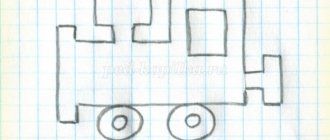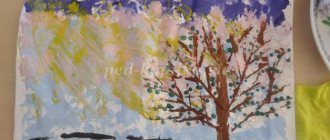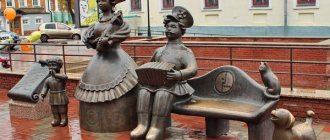Abstract of OOD in mathematics in the middle group using ICT. Count within 5
Abstract of OOD in mathematics “Playing and counting.”
Middle group Program content: Educational: 1. Learn to compare the number of objects and correlate them with numbers, as well as establish the sequence of events (parts of the day); 2. Practice the ability to distinguish and name familiar geometric shapes, circle, square, triangle, rectangle; 3. Continue to teach counting within 5; arrange the numbers in order from 1 to 5. Developmental: 1. Develop children’s motor activity, fine and gross motor skills, spatial orientation; 2. Develop attention, memory, thinking. Educational: 1. Accustom to listen to the teacher’s task and act in strict accordance with it. 2. Cultivate friendly relations in children, the ability to listen calmly to each other; Preliminary work: introduction and riddles about numbers 1, 2, 3, 4, 5; examination of geometric shapes; games: “Mathematical figures”, “What is round?”; learning physical education lessons. Looking at illustrations about the time of day. Equipment: slides with a picture of the country of Mathematics, a basket with geometric shapes (circle, square, triangle, rectangle) and large geometric shapes, hoops, cards with a task for k/r, colored pencils, cards with numbers, a magic box with gifts - “coloring books” ", Christmas trees, bench, easels.
Progress of OOD
Organizational moment. We will build an even circle, with a friend on the right and a friend on the left.
Let's hold hands together and smile at each other! Is everyone in a good mood? Are all your sorrows forgotten? I ask you to tell me: Are you ready to count and play today? (children's answers) - Guys, today the postman brought me a letter.
Want to know what's there? (The teacher reads a letter to the children.) “Hello guys!
My name is the queen of the country of Mathematics. And I invite you to visit me! I heard that you are very obedient, smart and smart guys, and I really want to meet you!” — Do you want to meet the queen of the country of Mathematics?
How do we go to a magical land? (children's assumptions) -And I suggest you go on foot. Because walking improves our health! We have a long way to go to the land of Mathematics. Let's go friends! There's no way you can fall behind! (To the song “It’s fun to walk together” - the children follow the teacher and along the path of health). 1 slide “Magic Country”
- Oh, guys, look where we ended up? And I know. We are in the land of Mathematics. We have to complete many tasks that the Queen of this country has prepared for us. And now the first task is who lives on this lawn, you will find out if you guess the riddles. Slide 2 Geometric shapes
1 task “Geometric shapes”. *** It looks like a wheel, and also like the letter O. It rolls along the road and hides in a daisy. His temper is not cool at all. Did you guess it? This is (circle) *** We build a house from it. And the window in that house. We sit down to it at lunch, and have fun at leisure. Everyone in the house is happy with him. Who is he? Our friend - (square) *** These figures are rushing around the city, taking children to kindergartens and schools.
There is a bus, a trolleybus, a tram. Look at the road, don't yawn! The houses look like this figure. What am I talking about? Answer, friends! (rectangle) *** The mountains are similar to it, It’s also similar to a children’s slide, And it’s also similar to the roof of a house. It looks very much like it. What did I wish for? It's a triangle, friends. - Well, now have you guessed who lives on this lawn?
(geometric figures) (The teacher hangs the guesses on the easel, the children stand in a semicircle) Game “Guess what’s in the basket” - The Queen of the Country of Mathematics has prepared a magic basket for us. Here she is standing under the Christmas tree. Let's try to guess what's in it? “You put your hand in the basket and find out by touch what kind of object it is, name it and then show it to all of us, and we check if you guessed correctly.” (Children stand in a semicircle, the teacher approaches each child. Children guess.) Game “Find your house.” — And now the geometric shapes offer you to play the game “Find your house.” — Once upon a time there lived geometric figures in their houses. What are they called, let's repeat it again? Circle, square, triangle and rectangle (the teacher shows and arranges large geometric shapes into hoops). I play mathematics, I turn you into figures!
One, two, three, triangle, run to the house! (triangle children run into their hoop).
- Well done boys! We did it! - But it’s time for us to move on! (children follow the teacher) 3 slide Numbers
Task 2 “Counting to 5” (Children with a teacher approach the tables) Put the numbers in order
- Look, guys, the numbers 1,2,3,4 and 5 decided to play around a little and got mixed up so much that they forgot their ordinal places.
Let's help them put things in order! (Each child has cards with numbers from 1 to 5. Children lay out the numbers on the tables in order). “Look, here in the clearing, the numbers are also mixed up, let’s help them too to fall into place.” (Five children come out and each take a number and stand up according to their number.) The teacher reads poems about numbers Like a soldier, one. There’s no way she can sit down: She’s standing at her post. The nose always looks to the left. Who does the deuce look like? Maybe for a duck? Rack! No, only a swan, arching its neck, can compare with her. A thin ring fell on the porch. It's split! Look - it turns out to be the number three. The wooden chair broke, But he was not at all confused: He stood upside down in the apartment, And became the number four. He knows the business of fisherwomen! The number five is a hook for him.
If you tie this number five with a fishing line to a stick, the stick will become a fishing rod... There will be glorious fishing! - Well done, you did everything right!
Count the drawn objects and connect the resulting answers with numbers (sitting at the tables) - And the queen of the country of Mathematics also left us a task. Let's see? (each child has a card with a task: count the drawn objects and connect the resulting answers with numbers) Well done, you completed this task. PHYSICAL MINUTE Perform movements corresponding to the teacher's demonstration to the music. Guys, do you hear what beautiful music is playing? Let's dance, because we are all friendly and can do everything. Warm-up dance “Strong Friendship.” - Well done! We completed all the tasks. We can move on! Slide 4 Queen - Look, guys, who is meeting us? (children are greeted by the queen of the country of Mathematics) showing an image on a slide - Hello, guys! How did you get to me? Was it difficult? What a great fellow you are! Do you want to play with me? And I’ll see how smart and quick-witted you are! Game "When does this happen?" Good morning - the birds are singing, Good people, get out of bed. All the darkness hides in the corners, the Sun rises and goes about its business! — Guys, what part of the day is this poem about? Slide 5 Parts of the day
—What other parts of the day are there? - The parts of the day always follow each other in order and this order is never violated! Game “Put the pictures in order” (Children place pictures depicting parts of the day in the correct order on an easel) We have breakfast in the morning and dinner (in the evening) We sleep at night and do exercises (in the morning) During the day we have lunch and have breakfast (in the morning) Sun shines during the day, and the moon (at night) We have dinner in the evening, and have lunch (in the afternoon) We go to kindergarten in the morning, and from kindergarten.... (in the evening) Result of OOD. After the games, the Queen of the Country of Mathematics addresses the children. Slide 6 Queen - It’s time for you guys to go back to kindergarten. I am very glad that you came to visit me! We completed many different tasks and managed to cope with everything. You were all attentive, resourceful, brave. I have a surprise for you... This magic box. I’m passing it on to you, and in the group, look at what’s in it. Goodbye! Come again! 7 slide the way home
(The children and the teacher return along the well-known route to the song “It’s Fun to Walk Together.”)
- Guys, we’re back at the kindergarten.
Where have we been? What they were doing? What was easy or difficult? Let's see what the Queen of the Country of Mathematics gave us? They open the magic box and take out coloring books with tasks. They say goodbye to the guests and leave.
Presentation on the topic: OOD on FEMP in the middle group “Playing and counting”
We recommend watching:
Notes on the development of elementary mathematical concepts in the middle group. Notes on the formation of mathematical concepts for children in the middle group. Notes on cognitive activity (mathematics) in the middle group. Our flag Organization of NNOD in mathematics in the middle group of kindergarten
Similar articles:
Math lesson notes “Number 1”. Middle group
Summary of mathematics lesson “Number 2” in the middle group
Summary of mathematics lesson “Number 3” in the middle group
Summary of mathematics lessons in the middle group. Digit 4
Methods for the development of sensory perception and logical thinking in preschool education
Recently, original methods for the early development of children have become increasingly popular; elements of original pedagogical techniques are successfully used by teachers of ordinary kindergartens. With the correct application of techniques, the child gradually masters more and more serious logical and mathematical operations, moving from simple manipulations with numbers to more complex computational exercises. Specialists can also use methods to diagnose the mental development of children for compliance with age standards in order to, if necessary, refer the child for an individual consultation with a child psychologist.
Logical blocks of the Hungarian mathematician Zoltan Gyenes
An effective gaming technique using a set of 48 geometric flat shapes and volumetric blocks of three primary colors (red, blue, yellow) and four shapes (circle, square, rectangle, triangle). In addition, volumetric blocks differ in thickness (thick-thin) and size (large-small).
The main goal of the original methodology is to teach skills in solving logical exercises and tasks based on classification by characteristics.
Games and exercises are presented in three difficulty levels:
- The first is that the child learns to operate with one property.
- The second one develops the skills of comparing and systematizing objects according to two criteria simultaneously.
- The third one offers tasks that require the ability to operate three properties at once.
Video: Dienesh logic blocks
https://youtube.com/watch?v=CV_PU3fUuf0
Maria Montessori Method
The Italian teacher and psychologist Maria Montessori developed a whole range of didactic materials:
- insert figures,
- rough letters,
- numerical machines,
- frames with clasps,
- other.
These teaching aids were specially developed to stimulate attention, the will to achieve success, observation, and concentration on the task, while their meaning was also for the child to find and eliminate his mistake, without the help of a supervisor.
Meaning of Montessori materials:
- arouse keen interest in completing the task, additionally motivating the child;
- enable the child to easily correct a mistake without the help of adults;
- maximize sensory perception;
- give priority to practical activities rather than abstract explanations, the child works a lot with his hands;
- break the learning process into component parts, which allows you to improve each stage separately;
- develop independence and autonomy;
- enhance concentration of attention, since they suggest the possibility of repetition without limiting the time for mastering the skill.
In kindergarten you can equip a corner with Montessori materials.
Games based on the Montessori method perfectly develop logical thinking.
Sensory development zone
With the help of auxiliary materials, the senses that the baby uses to understand the world around him are activated, and the child’s orientation in reality improves. The emphasis is on development:
- vision (plates of different colors, pink tower, geometric figures to understand differences in shape and size);
- hearing (musical instruments, bells, rustling boxes);
- sense of smell (jars with smell);
- touch (scraps of fabric, boards).
Mathematical area
Mathematical development sets the following goals for students:
- familiarity with numbers;
- understanding of numerical digits and the decimal system;
- mastering the mapping of mathematical symbols;
- ability to carry out basic mathematical operations of addition, subtraction, division with four-digit numbers;
- knowledge of the square of a number;
- Understanding fractions and working with them.
Didactic material:
- sets of gold beads and boxes with digital cards for learning arithmetic digits and mastering the skills of four actions;
- rods;
- spindles;
- Seguin boards.
Video: teaching mathematics in the Montessori system
Cuisenaire sticks
The method of the Belgian teacher George Cuisenaire suggests using a set of multi-colored counting sticks, differing in size and color, as a multifunctional mathematical aid for children from one to seven years old. The technique introduces the baby into the world of color and shape in a playful, relaxed way.
The meaning of the Cuisenaire technique:
- helps to clearly demonstrate the composition of a number, to form the concept of a logical sequence of a number series;
- improves attention, fine motor skills, stimulates imagination and fantasy;
- promotes the development of spatial thinking and combinatorial abilities;
- activates creativity, awakens interest in mathematical games and exercises.
Contents of games with sticks:
- sticks are used as a construction set, from which children model various shapes at random or according to picture instructions;
Children model various shapes freely or according to picture instructions.
- ladders to size;
The colored ladder helps to study the concept of quantity, as well as master counting skills - the formation and composition of numbers up to five, with the addition and subtraction of one stick;
- strengthening forward and backward counting skills.
The Cuisinaire set develops children's creative abilities
"Froebel's Gifts"
The method of the German teacher Friedrich Froebel involves the use of the author's game didactic material.
The goal of Froebel’s gaming methodology is to stimulate interest in active research activities, sensory development, and the formation of the child’s communication skills.
Didactic games “Froebel’s Gifts” for children 4–5 years old:
- a wooden cube containing eight more identical small cubes. The manual promotes familiarity with the concepts of whole and part, teaches counting, and develops design abilities;
- eight tiles that develop analytical skills;
- creative construction sets from cubes, geometric shapes, bars, etc.




